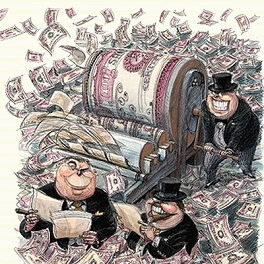Cross-posted from Paul Craig Roberts
In response to our account of the mysterious large rise in Belgium's Treasury purchases, it was suggested that the transaction would show up on the Fed's balance sheet. However, the Fed is under no obligation to show the transaction.
The $141.2 billion in Treasuries purchased into the Belgium account represents 3.2% of the total current size of the Fed's balance sheet. The Fed is a private corporation and is therefore not beholden to generally accepted accounting principles (GAAP) accounting standards. However even with GAAP standards applied, a corporation does not have to itemize and disclose the details of any event that represents less than 5% of its assets. In other words, the Fed can easily bury a 3% transaction in its financial statements.
There is evidence of mismatch in Federal Reserve financial statements. For example, at year-end 2013, the size of the Fed's balance sheet was $4.024 trillion. According to its latest report as of May 14, 2014, the size of the Fed's balance sheet is $4.360 trillion. Based on its QE bond purchase schedule since the beginning of 2014, the Fed's balance sheet should only have grown to $4.316 trillion by mid-May. In other words, the Fed's balance sheet as stated is $44 billion larger than it should have been had it been strictly following its QE schedule. (This assumes that 50% of May's QE purchase is reflected in the May 14 balance sheet report.)
There's also a "Flow of Funds" Statement that is connected to the balance sheet. It's a 167-page PDF report. But on page 20 of the PDF file, there's a table called "Total Credit Market Borrowing and Lending" (Table F.1). This table is defined as: "credit market borrowing and lending for all sectors, including domestic financial and nonfinancial sectors, and rest-of-the-world borrowing and lending with these sectors. Credit market borrowing or lending is defined as the transfer of funds between sectors through the following financial instruments: open market paper, Treasury securities, agency- and GSE-backed securities, municipal securities, corporate and foreign bonds, depository institution loans not elsewhere classified, other loans and advances, mortgages, and consumer credit."
The Rest Of The World line item under "credit market borrowing" (line 8) jumps up in Q4 2013 from Q3 2013 by $142 billion. While it might be coincidental that this line item happens to match the amount by which Belgium's Treasury holdings spiked up, it is a good example of areas on the Fed's operating statements where the type of transaction required to fund Belgium's purchases can be hidden.
Again, we emphasize, at just 3% of total Fed assets, the funding of the purchase of Belgium's bond purchases can easily be hidden, just like any big corporation, especially big banks, hide the details of significant portions of their assets off-balance-sheet. Moreover, opaque methods abound, and the $141 billion is tiny compared to the flow of funds. For example, the Fed does $4 trillion in overnight repo funding.
_______
*Dave Kranzler spent many years working in various analytic jobs and trading on Wall Street. For nine of those years, he traded junk bonds for Bankers Trust. He earned a master's degree in business administration from the University of Chicago, with a concentration in accounting and finance. Currently he co-manages Golden Returns Capital, a precious metals and mining stock investment fund based in Denver. He writes a blog to help people understand and analyze what is really going on in our financial system and economy: investmentresearchdynamics.com/






